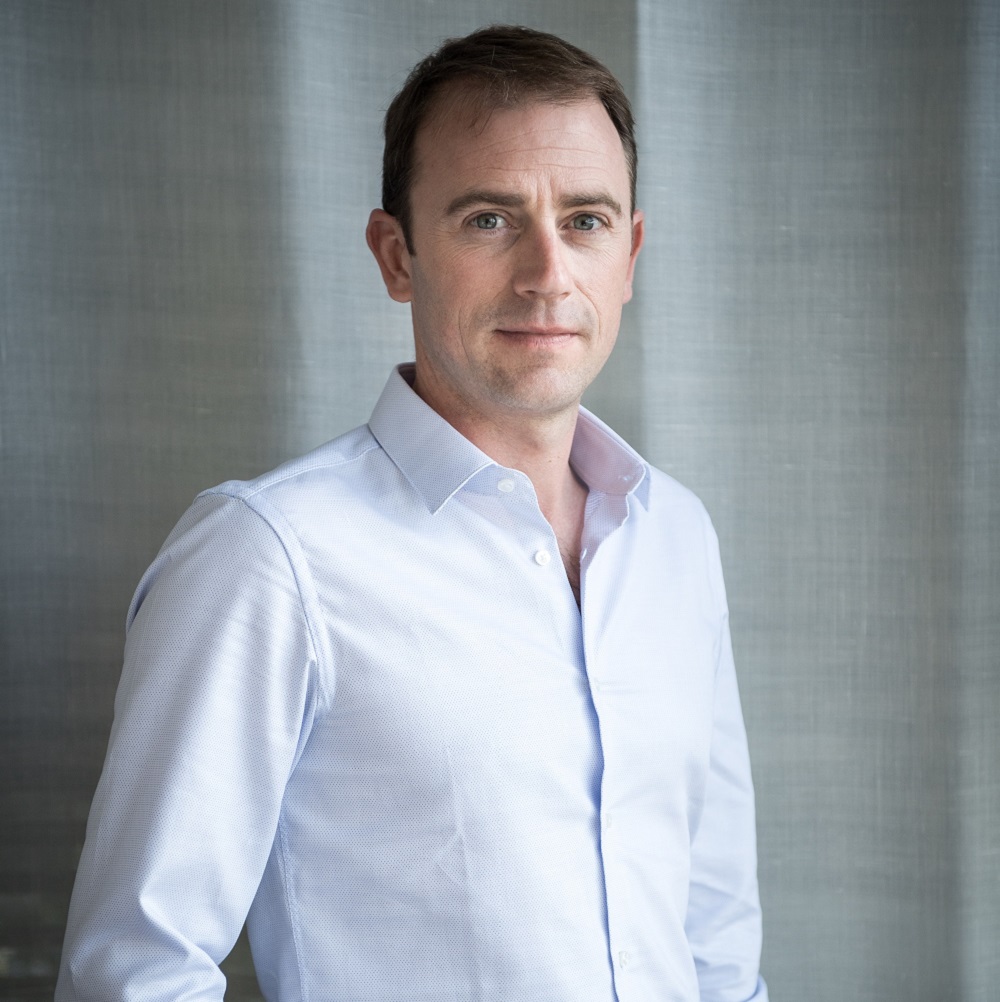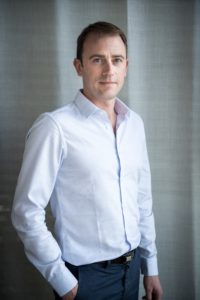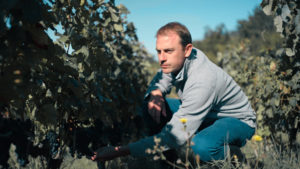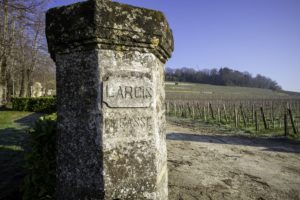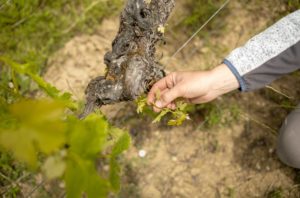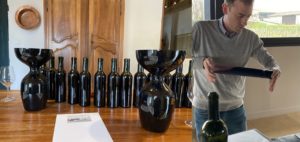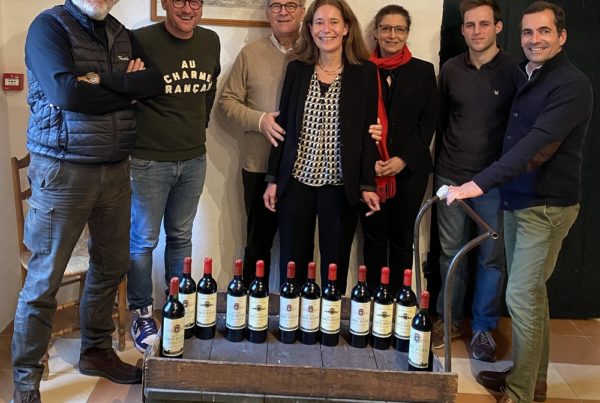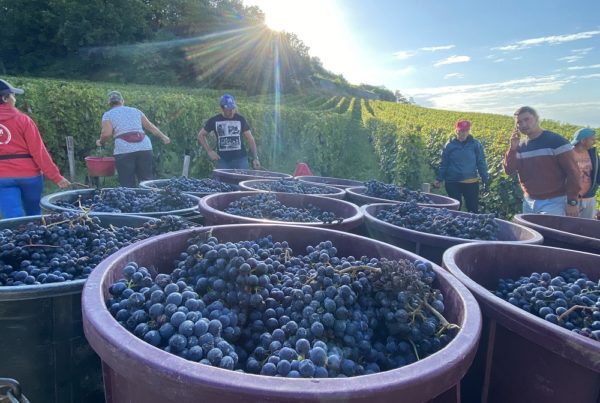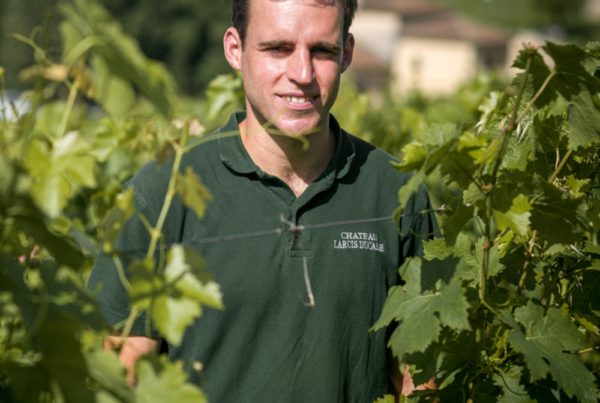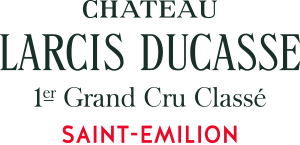Julien Lavenu, Consultant oenologist, Derenoncourt Consultants
Julien Lavenu has accompanied and advised the Château Larcis Ducasse team since 2002.
How would you define your job?
My job as a consultant is based on bringing a technical and sensitive experience to improve the balance of the vines and to make wines. With the help of empirical and scientific knowledge, I have to understand an environment and the people who work there. The technical part is added to a psychological part because it is a work that touches the human being. My job requires me to project myself, because I have to take the project of a domain, support it, guide it, sometimes avoid going in too extreme ways, keep a balance on a long time scale. To keep a distance, because it is this distance that guides my work.
As far as possible, I also accompany the wines made. This is a profession where we talk about know-how, transmission, sensitivity, but it is also a process of sharing knowledge. We are in contact with trade professionals and tasters. I have to be able to talk about the domains, the wines, so that they can shine more.
How did you become a consultant?
I come from an agricultural background that I fled because of the workload and the constraints it implied. I studied science, which allowed me to get away from the land in which I lived. I was interested in oenology, so I continued my studies in this field. I already had the pleasure of tasting wine since I was quite young, which I maintained thanks to members of my family. I projected myself in oenology as a multiple chemical environment that took me out of organic chemistry. It was through internships in the production environment that I felt I belonged. My “field” roots came out.
I met Stephane [Derenoncourt] during my last internship. He offered me a job after I finished my studies. I had imagined myself having multiple experiences abroad, but I got my foot in the door right away. I learned this job, which I didn’t expect to do, but it just happened! I experienced the beginnings of a very young consulting company. I was Stephane’s first employee in the company he founded with his wife Christine, which was born the same year I met him, in 1999. I took part in the development of Derenoncourt Consultant, in the phases of exploration of new territories: gradually, the activity extended to Aquitaine, then we left the region, then the borders of France.
Why do you feel in phase with the Derenoncourt Consultants philosophy?
This is the philosophy that runs through my veins, this definition of global vision. We are consultants who only sell our know-how (no analysis, no products): our experience, our knowledge, our sensitivity.
We have the opportunity to federate and revitalize estates by organizing tastings and events. This creates links between technicians and owners. These are moments of sharing. This is important.
What does Derenoncourt Consultants’ technical support consist of for wine estates like Larcis Ducasse?
In the 90s, Stéphane was technical manager and cellar master for several estates. Their successes, notably that of Château Pavie Macquin and the estates of Count von Neipperg, aroused interest. Other chateaus came looking for him. He then made the choice to become independent. At the beginning, he maintained the activity as he had done before. It was a very close guidance, almost management.
Today, after twenty years in the field, our role can be very different depending on the domain in which we intervene. It depends on the viticultural project, the potential and the existing management. We can offer intensive technical support: this is often the case in small vineyards where the technicians do not have a global vision or production philosophy. In larger, more structured estates, our role is not that of daily coaching. It’s a matter of bringing a viewpoint, a sensitivity and a sense of perspective. We are less involved in making decisions and more in contributing ideas. We evaluate somewhat perilous paths with a great deal of open-mindedness.
This is what we bring to Château Larcis Ducasse, which already has trained teams with skills. I bring observations, techniques that I have seen working or implemented elsewhere. Over the years, I try to be attentive to the evolution of each other, to capture the sensitivities or the claims to be able to rediffuse them into the project.
“In order to do good and beautiful things, the people involved in the day-to-day work have to be happy to do it. For all the work, from the vineyard to the winery, you need to believe in the right thing to do, in the beautiful thing to do, in the energy. As consultants, we are sensors or vectors of these situations. We can take them into account, because there is no hierarchical judgment. Our role is parallel.”
At Larcis Ducasse, the philosophy was put in place with a Derenoncourt vision and over the years, with the improvement of skills and the understanding of the particularities of the estate, the wine has become more identity. This was done gradually, thanks to a particular terroir, a favorable environment, but also because the chateau’s team wanted to move in this direction. At the beginning, I was talking about common practices because we know what works with this type of grape variety and in this environment, but there is always a will to go towards an identity and personalized taste. We are not trying to standardize the wines. We simply need to be very structured, to have a scientific vision, a thorough knowledge of oenology and agronomy, in order to be able to stand out. It is because today we have this mastery that we can allow ourselves to be more sensitive, and not the opposite.
In an estate like Larcis Ducasse, there is no logic in my intervening to talk about work techniques. I did that at the beginning, now it’s a given. Instead, we’re going to do campaign reviews on vigor behaviors for example, that seems more important to us. But there is nothing written down. It’s a tailor-made support.
Do you remember the first time you came to Larcis? What were your impressions?
I remember many times when I passed by Larcis Ducasse, before the collaboration started. Stephane lived next door at the time. It’s a road that he and I used to take every day.
“With the constitution of these terraces, this vineyard, this southern coast, the look towards Larcis was frequent. The site is very attractive, it’s a place that calls out! It’s a beautiful place that has been strongly shaped by humans and for a very long time, as the terraces attest.”
It’s not easy to work the vines there, but it’s often places like this where unique products are born. The first time I came, I thought I was in a very special place to make great wines. At the same time, it was at a time when the estate lacked dynamism and was living on its assets. So our goal was to revitalize. When we arrived at Larcis, there was a cellar master who did not taste the wine. This is nonsense! So yes, there were things to be done.
Since 2002, you have been accompanying and advising the Larcis Ducasse team, Nicolas Thienpont, assisted by David Suire. What were the first major works?
The first big job was to put in place a young, dynamic, structured and enthusiastic technical manager, namely David [Suire]. At the same time, the chateau invested in new equipment to work the vines better and in more efficient sorting systems. The size of the vats has been reduced to make finer selections.
Larcis Ducasse is a hillside vineyard. The foot of the slope is naturally richer because of the erosion phenomena that bring nutrients down. When the new team arrived in 2002, the heart of the hillside was producing too little, it was exhausted and most of the production was done on the bottom. We therefore worked to reduce the production of the most vigorous areas and above all, to encourage the viability of the soil and the vine to regain energy on the most beautiful hillside terroirs.
At the beginning, the parcel division was only based on our observations and the tasting of the berries. The hillside of Larcis is a succession of convex and concave areas with different water circulation and soil coverings. From the first year, with the team, we analyzed the vineyard by this division, by an observation of the behavior of the vine and the taste of the grapes. Our cuttings could be modified according to the style of the vintage, the climatology. When the estate was able to undertake a deep geological study, our intuitive cuttings were confirmed by the geological differences.
With the benefit of hindsight, we also realized some mistakes. For example, we wanted to preserve the estate’s heritage of old vines. We therefore planted a lot of vines in the first years, with limited success. In this environment where mechanical traffic is complicated, the young vines had difficulty developing. We lost some time before embarking on restructuring. We uprooted to replant better material, to develop the grape varieties, to increase the planting density. After twenty years, we say to ourselves that if we had started earlier, we would now have more vines in full exit of adolescence. But hey! The efforts were made out of time, and in a significant way given the size of the domain.
With the more marked, more extreme climatic effects that we observe today, what we put in place twenty years ago is perhaps not completely adapted either. We all make mistakes because we are installing cultural material for 50 years, 60 years and more. Fortunately, there is always a way to improve the resilience of the vine through adapted cultural practices.
What are the issues, the challenges of today and tomorrow?
We have been working for a long time on the issue of genetic diversity. Our approach is no longer to say: “there is one individual that is better than the others and we only plant that”, but on the contrary, to develop several individuals to have a multitude of shades, whether it is at the level of rootstocks but also the work of massal selection. It is a factor of complexity of the wine. As soon as the vines are not exactly the same, do not have exactly the same genome, we can imagine that the behavior of the grapes will be a little different. Some may be more resistant to diseases, others may tolerate a longer period of drought… Twenty years ago, vineyards had a unique vision of plant material and multiplied clones because it was comfortable and gave good results. But what is comfortable at one time can become a form of fragility later on, with a climatology that changes a lot depending on the vintage.
Are you referring to climate change?
It is necessary to perceive all the climate changes in order to keep soils and vines in good health. But we must not forget that the purpose of vineyards is the grape. Today, there is a generation of consultants, of practitioners who only see through the richness of the soil, the dynamics of the soil, or the vigor of the vine. Often, these specialists see only one element. Derenoncourt’s vision is a global one: geological, vegetal, environmental, viticultural and vinicultural…
A vine must be in good health to give good grapes but if it is too vigorous, it will not necessarily give the best grapes. There is this relationship with the effects of hydric stress, without being too marked. We are currently in a process of preservation: preservation of the vineyard, of the vitality of the soils, of the vines, to reach forms of balance that allow the vine to accept drier or hotter periods for longer. Our goal is to achieve correct behavior whatever the conditions. Some practices seem relevant at a certain moment of the vintage but may be less efficient for the following season. Our objective, plot after plot, is to try to “feel” the vintage, to imagine the future viticultural works to be set up, with plans B. To do this, the team of winegrowers must take hold of these subjects, be in close observation of the vine’s behavior.
What are the particularities of the Larcis vineyard?
Larcis Ducasse is a very sunny environment, due to its main exposure to the south. It is a place that captures a lot of light and this shows through in the wines, with an often airy dimension on the aromatic level. On the other hand, these are cool soils with important water reserves through the clay-limestone matrix.
“The particularity of Larcis Ducasse, then, is this balance between an environment turned towards the sun, being able to express a luminous solar character, but which also captures verticality, the energy of its soil.”
The noble clays imbue a sensual dimension in the curve and softness in the shape. The presence of limestone gives a tension in the mouth, an energy and a finish with a notable mineral dimension and an impression of freshness.
How can the diversity of the soils and terroirs of Larcis be explained and approached?
The diversity of the soils comes from the irregularity of the hillside: there are water passages, coverings, very different colluviums, and therefore sectors with slightly different growth behaviors. We speak of Côte Blonde for the terroirs with a finer covering before being on the marnes, which give us white, floral aromas and a lot of energy. We speak of Côte Brune to designate the darker brown soils, which reveal aromas of black fruits, a more licorice side, darker, with a lot of power and width in the mouth. The main framework of Larcis Ducasse is born from these associations. They form the basis of this mosaic, this puzzle. Then, other elements come to articulate and direct the style of Larcis according to the vintage, in particular the proportion of Merlot, of Cabernet Franc, the soils of the plateau, …
In the cellar, we kept the batches separated in barrels for the first few years to better understand this diversity of terroirs, because as soon as the wine is blended, we lose sight of it. We wanted to be able to follow the evolution of each zone but also to adapt the methods and duration of maturation, the proportions of wood, the types of toasting, according to the nature of each wine-making entity. At the time, we gave ourselves time to make our choices. Today, with Nicolas and David, we are working on the 20th vintage together. We know damn well where we are going! We have reduced the number of special maturing processes. Blending phases allow us to rebalance the wine earlier. But the fact that we taste the wines often and know where they are heading, also allows us to question them.
How do you explain the characteristic freshness found in the wines of Larcis?
This freshness comes from the soils but also from the respect in handling the wines. It is not because we have freshness in the grapes, that it will be persistent in the wine. If we mistreat the grapes, if we impose unsightly operations on them, we can lose this character. It must be preserved, and even exalted during ageing, especially in sunny vintages where the aromas can evolve.
Over the years, we have modified the types of containers to have wood for maturing that allows for aeration, an interesting combination while reducing the aromatic and sugary imprint on the wines. It’s a progressive approach so as not to create a rupture. For the last 7-8 years, we have been using 500-liter barrels. Glass Wine Globes arrived more recently. They are complementary to the barrels but are not self-sufficient. A new step in 2021 is the integration of a foudre, always with the idea of preserving the fruit, the brightness and the tension that we have in the grapes. The smaller and more heated the barrels, the more sugar we get, which can make us lose that mineral tension.
Can you tell us a word about the 2021 vintage?
It was a vintage that required a lot of human and economic resources, that was very tiring, that caused physical and mental wear and tear. We had a succession of great pressures, never very comfortable periods. The vintage started with the risk of frost, then a significant development of the vine, a pressure of diseases, wet conditions that did not allow us to work as we wanted. We had to prioritize each time. It was laborious.
The summer was not very luminous, even for naturally favored environments like Larcis. This vintage will be marked by a fresher aromatic, relatively different alcohol balance, which was more common in the 2000s. It is not a vintage of great concentration, it is a little more stretched out in its constitution. It will be necessary to preserve its elegance. Larcis Ducasse is an estate that is doing well, that has succeeded in saving its grapes, where we have been able to make real choices about the harvest and not suffer from it. In order to be in the continuity of the Larcis Ducasse vintages, we will have to make rather severe choices in the selection of the first wine. But it is still a little early to talk about it.
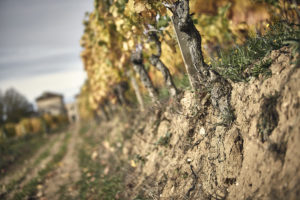 –
–
Most beautiful emotion of tasting? On the one hand, it is to taste wines that have gone through time, very old wines, that challenges us and transforms us. It allows us to put our role and place into perspective and to thank the people who have carried out a goldsmith’s work out of conviction. But also, when we follow a domain for twenty years or more and we have the opportunity to taste side by side the vertical, it is always a strong moment.
A grape variety? I don’t have a favorite grape variety. I am more looking for a saline dimension in the wine. My favorite grape varieties are good indicators of their place of production. I particularly appreciate clay-limestone soils for what they can bring in the aromatic palette, the touch of mouth and the finesse.
A dish? A veal chop accompanied by noble mushrooms, with a Larcis Ducasse completed with notes of truffles, humus, meat juice… This dynamic suits me well!
A book? Jamais seul, by Marc-André Selosse, for the human/land/environment link. He is very educational. He talks here about all the micro-organisms that are in us or around us, that make it possible for us to live. Without them, we are not able to absorb most of the food that we need. There are also microbes that can be pathogenic to plants, that live alongside, and at some point they merge with the plant organism and become the same individual, through evolution. This is where I make the connection with the vine and the balance of a soil.
A trip? Tuscany. It is a region that I appreciate very much. I also find that, although very much rooted in Gironde, the environment of Larcis reveals a Tuscan side: this “Mediterranean barrier”, this relief, this very luminous side, the color of the shutters which reminds us of cypresses… Jacques-Olivier [Gratiot] would certainly see in it more a Corsican accent…
Thank you Julien!
www.derenconourtconsultants.com
